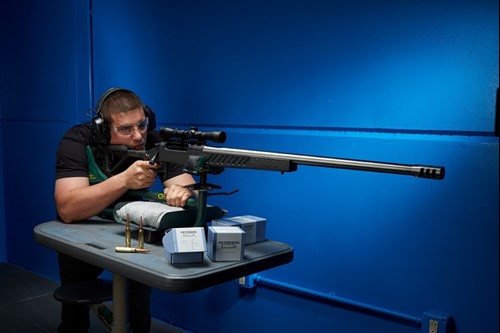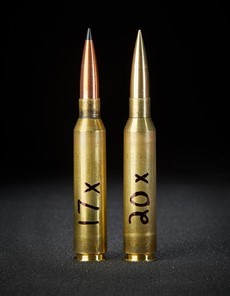CheyTac – Consistent muzzle velocities
(October 2016)

|
Here is the latest update on our progress to finish the caliber development on the calibers the industry refers to as the CheyTac® calibers. (We refer to the .408 as 10.36 x 77. We refer to the .375 as 9.5 x 77.)
Our goal has always been to make the most CONSISTENT casings in the business. If they are consistent from casing to casing in internal volume and external dimensions, then the shooter will experience the most consistent results at the target. Consistent dimensions result in consistent internal volumes, which result in consistent pressures, which result in consistent muzzle velocities, which can result in placing multiple bullets in the same hole at the target.
Last Friday our president, Derek Peterson was life testing our most recent iteration of the 9.5 x 77. He started with five casings, and did a full-body resizing after each firing. It is not what a shooter would do, but we wanted to put the cases through the harshest rigor they could be subjected to. He got 17 firings out of each before he started to notice the early signs of case head separation. He then took another set of casings and after each firing he just bumped the shoulder back, like a typical reloader would. He got 20 firings out of those casings.
 Peterson casings for guns chambered in the CheyTac .375 |
As many of you probably already know there is no SAAMI spec on these calibers. So without a SAAMI spec there is no stated maximum pressure for a service load. However there is an international spec on the .408. The international standards organization is CIP. The letters stand for Commission Internationale Permanente. And the max pressure they list for this round is extremely high. Our partner in Europe tells us it is probably unnecessarily high. Our partner loads these rounds and they have a standard load for the .375s which is also quite high. So that is the pressure we did our testing at. To even achieve that pressure we had to use a “compressed” load. We are explaining all this to say that you probably won’t be using a load that hot, and therefore will most likely get more reloads than we did, if you try to.
But here is the news that made Derek the happiest. On the first two shots the muzzle velocities were within 12 feet per second of each other. On the 3rd and 4th shots the muzzle velocities were within 6 feet per second of each other. By the 5th shot the muzzle velocities were within 1 foot per second of each other. Now that is how you can put two bullets in the same hole down range.
CheyTac® is a registered trademark of CheyTac USA, LLC. Peterson Cartridge is not affiliated with, or sponsored by CheyTac USA.